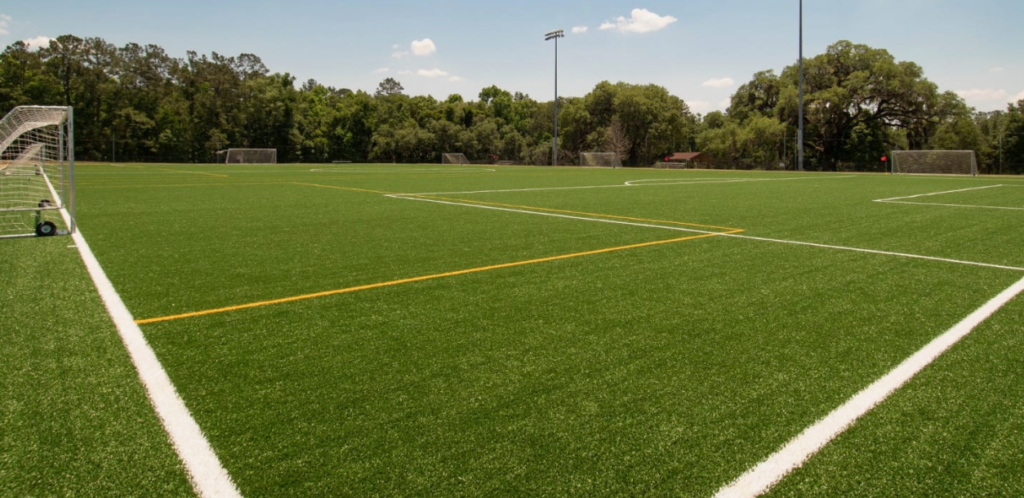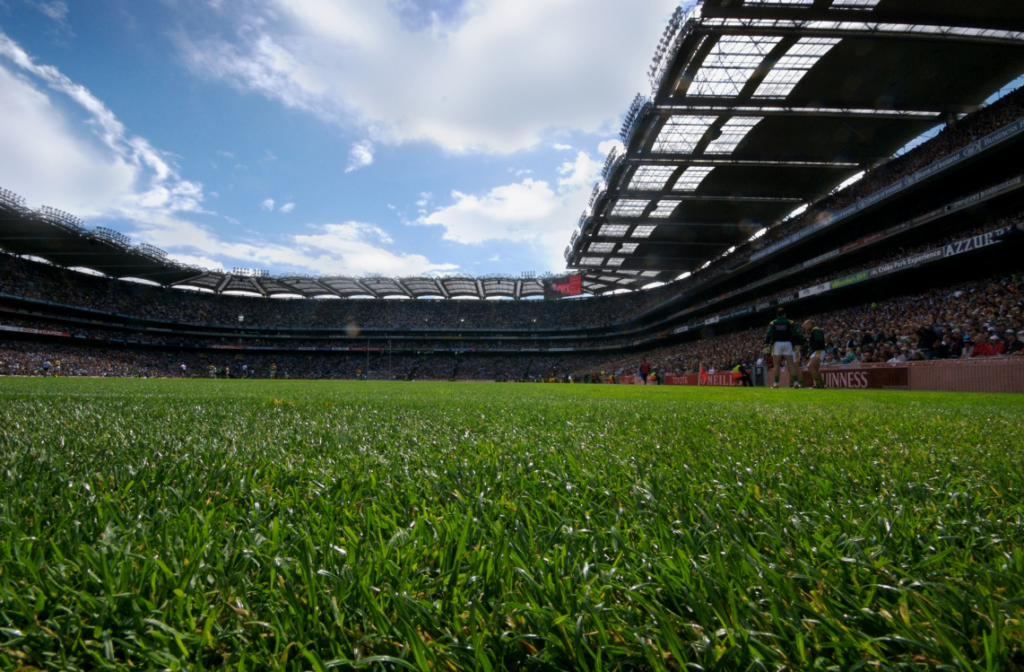A backyard soccer field provides a convenient space for sports and recreation activities. It offers opportunities for playing games and practicing skills, enhancing physical fitness and enjoyment. With the right equipment and surface material, creating a backyard soccer field can be a fun and rewarding project. You can determine the size and layout, choose between natural grass or artificial turf, and set up goals for an authentic playing experience.
Proper maintenance of the field is essential for long-term enjoyment and performance. Whether for casual games with family and friends or serious training sessions, a backyard soccer field can be a valuable addition to any outdoor space.
Backyard Soccer Field

Benefits of Having A Backyard Soccer Field
Having a backyard soccer field offers a myriad of benefits for both physical and social well-being. Not only does it provide a convenient space to practice and enjoy the game, but it also promotes physical activity and fosters social interaction among family and friends. Let’s explore the various advantages of having a backyard soccer field.
Physical Health Benefits- Backyard Soccer Field
- Promotes Physical Activity: Playing soccer in the backyard encourages regular physical exercise, contributing to improved cardiovascular health and overall fitness.
- Enhances Coordination and Agility: Running, dribbling, and kicking the ball on a backyard soccer field help develop coordination and agility.
- Strengthens Muscles: The game involves various muscle groups, leading to strength and endurance development.
- Improves Balance and Flexibility: Constant movement and quick changes in direction improve balance and flexibility.
Social Benefits- Backyard Soccer Field
- Family Bonding: A backyard soccer field creates opportunities for family members to engage in physical activity together, fostering stronger bonds.
- Social Interaction: Playing soccer with friends and neighbors on a backyard field promotes social interaction and teamwork.
- Healthy Competition: Friendly matches on the field encourage healthy competition and sportsmanship.
- Outdoor Recreation: It encourages spending time outdoors, away from screens, and enjoying nature.
Designing Your Backyard Soccer Field
Transform your backyard into a soccer haven with a custom-designed field. Maximize your playing space for endless fun and practice sessions. Create a mini pitch tailored to your needs and enjoy the game right at home.
Choosing The Right Location
When it comes to designing a backyard soccer field, the first and most crucial step is choosing the right location. The chosen area should ideally have ample space, be relatively flat, and be free from obstructions such as large trees or shrubs. It should also receive adequate sunlight to promote the healthy growth of grass or turf. A well-located field not only enhances the playing experience but also ensures safety for the players. Consider the backyard soccer field size to the available space to determine the optimal location.
Selecting The Right Size
Selecting the appropriate size for your backyard soccer field is essential to ensure an enjoyable and competitive game. The standard size for a soccer field ranges from 50 to 100 yards wide and 100 to 130 yards long for professional play. However, for a backyard setup, the size can be adjusted based on the available space and the intended use. It’s important to consider the backyard soccer field cost when determining the size, as larger fields may require more maintenance and initial investment.
Picking The Right Surface Material
The surface material of your backyard soccer field plays a significant role in the overall playing experience. Options such as natural grass, artificial turf, or compacted soil each have their advantages and considerations. Natural grass provides a traditional feel but requires regular maintenance, while artificial turf offers durability and minimal upkeep. The choice of surface material should align with the intended use, maintenance capability, and budget for the backyard soccer field.
Essential Equipment For Your Backyard Soccer Field
Creating a backyard soccer field is an excellent way to promote physical activity and enjoy the beautiful game right in your own home. To make the most of your backyard soccer field, it’s important to have the essential equipment that ensures safety, fun, and a fulfilling soccer experience for players of all ages.
Goal Posts
Goal posts are a fundamental part of any soccer game, and having them in your backyard adds authenticity to the playing experience. You can opt for portable or permanent goal posts, depending on your backyard soccer field cost and space availability. Portable goals are convenient and can be easily moved, while permanent ones offer durability and stability. Ensure the goalposts are securely anchored to the ground to prevent any accidents during play.
Soccer Balls
Soccer balls are the heart of the game, and having a good collection of balls ensures uninterrupted play and practice sessions. It’s advisable to have various sizes of soccer balls to accommodate different age groups and skill levels. Consider investing in high-quality, durable balls that can withstand outdoor conditions, ensuring a longer lifespan and reducing the backyard soccer field price in the long run.
Shin Guards
Shin guards are essential for player safety, especially for younger participants. They protect the lower legs from potential injuries during tackles, collisions, and falls. When purchasing shin guards, ensure they fit properly and provide adequate coverage for the shins. Comfortable and well-fitted shin guards can encourage players to engage in the game confidently and without the fear of injury.

Safety Measures For Your Backyard Soccer Field
Create a safe backyard soccer field by installing proper padding under the turf and ensuring secure goalposts. Regularly inspect and maintain equipment to prevent injuries during play. Consider adding boundary lines to establish clear playing boundaries for a fun and safe experience.
Playing soccer in your backyard is a great way to get some exercise and have fun with your family and friends. However, it’s important to take safety measures to prevent injuries. Here are some safety tips to keep in mind when building and maintaining your backyard soccer field.
Installing Proper Lighting
One of the most important safety measures for your backyard soccer field is installing proper lighting. If you plan to play soccer at night, make sure your field is well-lit to prevent accidents and injuries. You can install floodlights or LED lights around the perimeter of your field to provide enough illumination. Make sure the lights are placed at the right height and angle to avoid glare and shadows on the playing surface.
Adding Safety Netting
Another safety measure for your backyard soccer field is adding safety netting around the perimeter of the field. This will help prevent the ball from flying out of the field and causing damage or injuries to people or property. You can use mesh netting or chain-link fence to create a barrier around your field. Make sure the netting is securely fastened to the posts and poles to prevent it from sagging or tearing.
Regular Maintenance
Maintaining your backyard soccer field regularly is essential to ensure its safety and longevity. Check the surface of the field for bumps, holes, or uneven spots that can cause tripping or ankle injuries. Fill in any holes or level the surface if necessary. Also, check the netting and posts for any signs of wear or damage and repair or replace them as needed. Finally, keep the field clean and free of debris to prevent slips and falls. By following these safety measures, you can enjoy playing soccer in your backyard without worrying about injuries or accidents. Remember to always wear appropriate footwear and protective gear, and to play responsibly.
Landscaping Tips For A Backyard Soccer Field
Having a backyard soccer field is a great way to keep your kids entertained and active. However, maintaining the field can be challenging. In this article, we will provide you with some landscaping tips for a backyard soccer field that will help you keep your field in top condition.
Grass Maintenance
One of the most important aspects of maintaining a backyard soccer field is grass maintenance. You need to ensure that the grass is healthy and well-maintained to provide a safe playing surface for your children. Here are some tips for grass maintenance:
- Water the grass regularly to keep it hydrated.
- Mow the grass at least once a week to keep it short.
- Aerate the grass to improve drainage and promote healthy root growth.
- Fertilize the grass to provide it with the nutrients it needs to grow.
Creating Boundary Lines
Creating boundary lines for your backyard soccer field is important to ensure that the players stay within the designated playing area. Here are some tips for creating boundary lines:
- Use cones or flags to mark the corners of the field.
- Use a measuring tape to measure the dimensions of the field and mark the lines with spray paint.
- Install a permanent fence around the field to keep the ball from going out of bounds.
Adding Seating Areas
Adding seating areas to your backyard soccer field is a great way to make it more comfortable for spectators. Here are some tips for adding seating areas:
- Install benches or chairs along the sidelines of the field.
- Provide shade with umbrellas or a canopy to protect spectators from the sun.
- Make sure the seating area is located in a safe location away from the playing area.
By following these landscaping tips, you can create a safe and enjoyable playing surface for your kids to enjoy.
Organizing Soccer Matches In Your Backyard
Creating a backyard soccer field opens up endless possibilities for fun and friendly competition. Whether you have a small backyard or a spacious outdoor area, numerous backyard soccer field ideas can transform your space into a mini soccer haven. With some creativity and planning, you can host tournaments, invite friends and neighbors, and create a schedule for regular matches, turning your backyard into a hub for soccer enthusiasts.
Setting Up Tournaments
Setting up tournaments in your backyard can add excitement and a sense of competition to your soccer matches. You can organize mini-leagues or one-day tournaments, dividing players into teams and establishing a point system. Consider creating a simple bracket system or round-robin format to determine the ultimate backyard soccer champions. To enhance the experience, you can even award small prizes to the winning team, adding an extra layer of motivation and enjoyment to the games.
Inviting Friends And Neighbors
Inviting friends and neighbors to join your backyard soccer matches can foster a sense of community and camaraderie. Reach out to fellow soccer enthusiasts in your area and extend a friendly invitation to participate in your backyard soccer games. You can create a welcoming environment by providing refreshments and snacks, encouraging players to socialize and bond over their shared love for the sport. By building a network of soccer-loving individuals, you can establish a regular gathering for enjoyable matches in your backyard.
Creating A Schedule
Creating a schedule for your backyard soccer matches ensures that everyone has the opportunity to participate and enjoy the games. Set specific days and times for matches, allowing players to plan and prioritize their involvement. Additionally, establishing a rotating system for team selection can promote inclusivity and fairness, ensuring that all participants have the chance to play alongside different teammates. By maintaining a consistent schedule, you can cultivate a dedicated community of players who eagerly anticipate the next game on your small backyard soccer field.
Incorporating Training Drills And Exercises
Enhance your backyard soccer experience by incorporating various training drills and exercises. These activities not only improve your skills but also make the game more enjoyable. By dedicating time to practice different techniques, you can elevate your game and have fun while doing so.
Dribbling Drills
Dribbling is an essential soccer skill, and practicing dribbling drills can significantly improve your ball control and agility. Set up cones or markers in your backyard to create a course for dribbling exercises. Challenge yourself to navigate through the obstacles while maintaining control of the ball. This will help enhance your dribbling skills and footwork, making you a more versatile player on the field.
Passing Exercises
Passing is a fundamental aspect of soccer that requires precision and teamwork. Incorporate passing exercises into your backyard training routine to improve your accuracy and decision-making. Set up targets or use a wall to practice passing and receiving the ball. Focus on different types of passes, such as short passes, long passes, and through balls, to develop a well-rounded passing game.
Shooting Practice
Shooting is the ultimate goal-scoring skill, and regular shooting practice can significantly enhance your scoring ability. Create shooting drills in your backyard to work on your accuracy and power. Set up targets or use a goal to practice various shooting techniques, such as volleys, headers, and one-on-one finishes. Consistent shooting practice will sharpen your ability to find the back of the net during game situations.
Maintaining The Longevity of Your Backyard Soccer Field
Ensuring the longevity of your backyard soccer field requires diligent care and maintenance. By implementing proper drainage systems, timely resurfacing, and protection against pests, you can extend the lifespan of your soccer field, allowing for countless hours of play and enjoyment.
Proper Drainage System
Effective drainage is crucial for preventing water accumulation and potential damage to the turf. Ensure that your soccer field is equipped with a well-designed drainage system, including appropriate slope and drainage channels, to facilitate the swift removal of excess water.
Resurfacing When Needed
Regularly assess the condition of the turf and resurface as necessary to maintain an even and durable playing surface. Over time, natural wear and tear, as well as weather conditions, can impact the quality of the field. Timely resurfacing helps to address any issues and prolong the lifespan of the turf.
Protecting Against Pests
Implement measures to safeguard your backyard soccer field against pests that can cause damage to the turf. Utilize appropriate pest control methods, such as natural repellents or barriers, to prevent infestations and preserve the integrity of the playing surface.

Frequently Asked Questions
What size is a backyard soccer field?
A backyard soccer field typically ranges from 50-100 feet wide and 100-130 feet long.
How to make a soccer field in the backyard?
To make a soccer field in the backyard: Choose an area, determine size, select surface material, get equipment, and check local regulations.
How to grow soccer field grass?
To grow soccer field grass, prepare the soil by removing existing grass, leveling the ground, and adding topsoil/compost for fertility.
How big is a mini soccer field in feet?
A mini soccer field is typically around 50 feet by 100 feet in size.
Conclusion
Having a backyard soccer field can enhance your playing experience and provide endless fun. With proper planning and the right equipment, you can create your mini-soccer pitch right at home. Get ready to enjoy exciting matches and improve your skills with a custom backyard soccer field.

